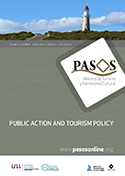The relationship between public action and tourism from various perspectives: ideas, actors and institutions
DOI:
https://doi.org/10.25145/j.pasos.2016.14.037Keywords:
tourism, situational phenomenon, social dynamics, public officialsAbstract
urism is a situated phenomenon and its development generates social, cultural, environmental and economic dynamics with both positive and negative effects. That's why the importance of the role of public agents, of the actors involved in the management of the collective, of tourism policy or, in other words, of what happens in public space, is unquestionable. In this issue all the papers reflect on different dimensions of the relationship between public action and tourism.
We use the term public action even though we are aware of its elasticity. We understand public action to be the initiatives of legitimate governments which, in democratic contexts, have the responsibility to make decisions to improve the space of the collective, of course according to the principles and values of their ideology, since we are in the world of politics. But we want to focus expressly on analysis. We are talking about action or actions. That is why our work is oriented towards the field of policies and/or programmes designed and implemented by governments at different levels.
The different works show that this is a very broad field of analysis that allows for very diverse questions that can be answered from a plurality of disciplinary and analytical approaches. In fact, there is abundant literature on this subject and, increasingly clearly, it is assumed that tourism generates conflicts that have to be faced by governments, overcoming the resistance to linking the ideas of tourism and conflict.
The vast majority of the papers in this issue were presented in a first version to the GIGAPP Congress held in Madrid in October 2015, to a Working Group coordinated by the authors of this editorial under the title "Tourism Policies: Methodological Proposals, Cases and Comparative Analysis". Its variety and richness is representative of the growing interest in this issue.
From the reading of the different articles it can be stated that variety is the most significant feature, however there are questions that cross all the reflections of the present monograph. Firstly, the problems affecting the government of destinations, or public action in the field of tourism, are complex and cross-cutting and involve the intervention of actors with very different logics and outlooks. Secondly, that it is increasingly necessary to improve the field analysis of public action in the field of tourism and destination government, and that in this sense it is essential to incorporate new, more qualitative perspectives and new methodologies generated in various social sciences, with the aim of complementing the predominant quantitative studies and their limitations. By
The relationship between public action and tourism from various perspectives
Finally, an idea present in all is the need to seek complementarities with theories and models that come from other scientific fields.
Downloads
Publication Facts
Reviewer profiles N/A
Author statements
- Academic society
- PASOS. Revista de Turismo y Patrimonio Cultural
- Publisher
- Instituto Universitario de Investigación Social y Turismo. Universidad de La Laguna (España) - Instituto Universitario da Maia ISMAI (Portugal)
Downloads
Published
How to Cite
Issue
Section
License
I confirm that the work is original (of my/our authorship), and that it will not be submitted to other journals or publications until the final resolution of the review process in PASOS, RTPC.
I authorize the publication of my work by PASOS, PSTN of free and open access in any of the formats that I deem appropriate, for an indefinite period of time and as a non-remunerated collaboration.
Likewise, the author(s) understands that the published work may be linked or deposited on any server or included in other publications (republication), provided that the new place and/or new edition references the original publication and acknowledges the authorship and copyright ownership of PASOS RTPC publications.
Authors understand that a plagiarism-self-plagiarism check will be performed, and the article may be removed at any time from the editorial flow.










